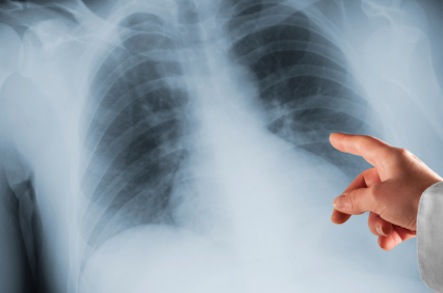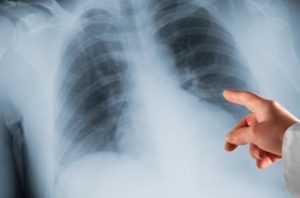
Bacterial pneumonia – causes, side effects and treatments at NaturalPedia.com
Friday, January 12, 2018 by Frances Bloomfield
http://www.naturalpedia.com/bacterial-pneumonia-causes-side-effects-and-treatments-at-naturalpedia-com.html

Bacterial pneumonia is a type of pneumonia, a common long infection wherein the air sacs of one or both of the lungs become inflamed. This in turn can result in the air sacs filling up with fluid, making it more difficult to breath and sometimes causing the lungs to receive insufficient oxygen. As implied by the name, bacterial pneumonia is caused by bacteria that have entered and multiplied within the lungs. According to Healthline.com, these bacteria are:
- Streptococcus pneumonia: The primary cause of bacterial pneumonia, Streptococcus pneumonia typically enters the lungs either through inhalation or the bloodstream. This particular type of bacteria can cause a person to expel rust-colored sputum or phlegm, a mucus-like substance secreted into the airways.
- Haemophilus influenzae: Second only to Streptococcus pneumonia as a cause of bacterial pneumonia, Haemophilus influenzae can be found in the upper respiratory tract. As per Emedicine.Medscape.com, it can produce green sputum.
Typically, one can become exposed to these bacteria in and outside of a healthcare setting, which led to the two known classifications of bacterial pneumonia: community-acquired pneumonia (CAP) and hospital-acquired pneumonia (HAP). Between the two, CAP is more common and easier to treat. Moreover, CAP can be acquired through skin-to-skin contact or by breathing in the respiratory droplets of sneezes and coughs. By contrast, HAP is more difficult to treat due to this type of pneumonia having a resistance to antibiotics.
People who have weakened immune systems, existing respiratory disease, or are recovering from surgery are at high risk of becoming infected. Environmental and lifestyle factors, such as working in a pollution-dense environment or having a predilection to smoking, can make one more susceptible to bacterial pneumonia as well.

Known side effects of bacterial pneumonia
This condition will most often cause people to experience these symptoms:
- Chills
- Confusion
- Cough with thick green, yellow, or red mucus
- Exhaustion
- Fever
- Headaches
- Loss of appetite
- Muscle pain
- Shortness of breath
- Stabbing chest pains that become worse when breathing or coughing
- Sweating
Children and infants will typically display the aforementioned symptoms. In some cases, however, children may exhibit blue-tinged lips or nails, indicative of their difficulty breathing.
If no treatment is given, complications may arise, namely:
- Lung abscess
- Pleural effusion: Also known as water on the lungs, this is the build-up of excess fluid between the pleural layers of the lungs.
- Respiratory failure: This can occur when there is too much carbon dioxide in the lungs, or if there isn’t enough oxygen.
- Sepsis: A life-threatening condition caused by infection, sepsis can result in damage across multiple organ system.s
Body systems harmed by bacterial pneumonia
Bacterial pneumonia primarily affects the lungs. If allowed to progress further, however, other organs and organ systems may be affected. This is because bacterial pneumonia can lead to sepsis, also known as blood poisoning. The kidneys, liver, and the brain are all at high risk of organ failure should a person ever develop sepsis.
Food items or nutrients that may prevent bacterial pneumonia
As with many diseases, fruits and vegetables are highly recommended to prevent or alleviate the symptoms of pneumonia. In particular, colorful fruits and dark, leafy greens are the best for this because of their high antioxidant content. Antioxidants can both strengthen the immune system and help the body recover from infection at a much quicker pace.
Selenium is another nutrient that can support immune system function. This beneficial mineral is found in whole grains like oats and barley.
Treatments, management plans for bacterial pneumonia
Depending on its severity, a case of bacterial pneumonia will either be treated at the hospital or at home. A person who is undergoing home care for bacterial pneumonia will typically be prescribed antibiotics to target the bacteria and other medications to help ease any pains or reduce fever. The affected person should get plenty of bed rest and drink great amounts of fluids to prevent dehydration. Smoking should be stopped too as it can damage the lungs.
In the event that hospitalization is necessary, one can expect to be intravenously given antibiotics and fluids through a drop. An oxygen mask may be provided in case breathing assistance is required.
Where to learn more
- Dangerous, experimental pneumonia vaccine injected into 2-month old babies and adults after major surgery; contains multiple strains of pneumonia plus aluminum
- Life-threatening Pneumonia Caused by Pneumonia Vaccine
- Pneumonia vaccines being pushed on seniors with cancer despite manufacturer’s warning of adverse reactions
- Pneumonia, swine flu outbreak barely contained at U.S. naval base housing illegal immigrant children north of Los Angeles
- Statins Given to Prevent Pneumonia in Elderly Actually Increase Pneumonia Risk by 61 Percent
Summary
Bacterial pneumonia is a type of pneumonia caused by bacteria. Exposure to these microorganisms can occur within and outside of a healthcare setting, and can most affect people with compromised immune systems or existing respiratory illnesses. A person who has acquired bacterial pneumonia will usually exhibit symptoms such as chest pains whenever they cough or breath, coughing with mucus, fevers, and chills. As such, the lungs are most affected by bacterial pneumonia, although the liver, kidneys, and brains can also be affected if bacterial pneumonia has progressed to the point where the patient has sepsis.
Bacterial pneumonia can be treated within the home and at a hospital, but this depends on its severity. Eating foods rich in antioxidants and selenium is recommended as these can help boost the immune system.
Sources include:
Tagged Under: Tags: Bacterial pneumonia





